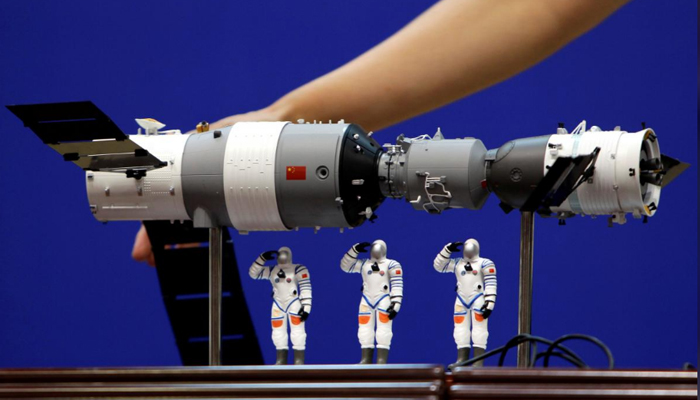No damage found on ground due to Chinese spacecraft crash
Tiangong-1 was launched in 2011 to carry out docking and orbit experiments as part of China’s ambitious space programme
April 02, 2018

BEIJING: The Tiangong-1 target space module re-entered the earth’s atmosphere around 8:15am on Monday, Beijing time, but no damage was found on the ground, said the Chinese foreign ministry spokesperson.
Chinese foreign ministry spokesperson Geng Shuang said the re-entry points of Tiangong-1 is located in the central area of the South Pacific. Most parts of the device were burnt up on re-entry into the earth’s atmosphere, he added.
He further said that China has always attached great importance to the re-entry of Tiangong-1 to the earth and has been handling this matter in accordance with international conventions and practices in a highly responsible spirit.
“China has repeatedly informed the relevant department of the United Nations about the situation and kept the information open and transparent,” he said.
Earlier, the Chinese space authority had said the craft was expected to re-enter the atmosphere off the Brazilian coast in the South Atlantic near the cities of Sao Paulo and Rio de Janeiro.
The United States Air Force 18th Space Control Squadron, which tracks and detects all artificial objects in Earth’s orbit, said it had also tracked the Tiangong-1 in its re-entry over the South Pacific.
It said in a statement it had confirmed re-entry in coordination with counterparts in Australia, Canada, France, Germany, Italy, Japan, South Korea and Britain.
The remnants of Tiangong-1 appeared to have landed about 100 km (62 miles) northwest of Tahiti, said Brad Tucker, an astrophysicist at Australian National University.
“Small bits definitely will have made it to the surface,” he told Reuters, adding that while about 90% would have burnt up in the atmosphere and just 10% made it to the ground, that fraction still amounted to 700 kg (1,543 lb) to 800 kg (1,764 lb).
“Most likely the debris is in the ocean, and even if people stumbled over it, it would just look like rubbish in the ocean and be spread over a huge area of thousands of square kilometres.”
Beijing said on Friday it was unlikely any large pieces would reach the ground.
The 10.4-metre-long (34.1-foot) Tiangong-1, or “Heavenly Palace 1”, was launched in 2011 to carry out docking and orbit experiments as part of China’s ambitious space programme, which aims to place a permanent station in orbit by 2023.
It was originally planned to be decommissioned in 2013 but its mission was repeatedly extended.
China had said re-entry would happen in late 2017, but that process was delayed, leading some experts to suggest the space laboratory was out of control.
Worldwide media hype about the re-entry reflected overseas “envy” of China’s space industry, the Chinese tabloid Global Times said on Monday.
“It’s normal for spacecraft to re-enter the atmosphere, yet Tiangong-1 received so much attention, partly because some Western countries are trying to hype and sling mud at China’s fast-growing aerospace industry,” it said.
With additional input from Reuters











